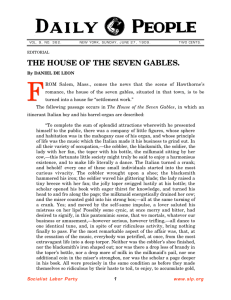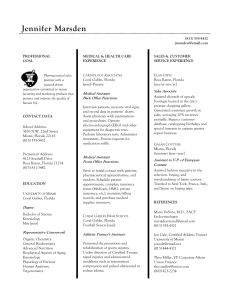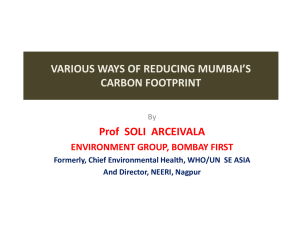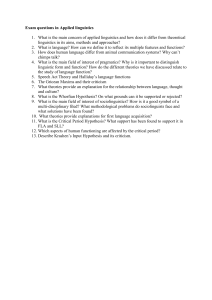Petitioner's Reply Brief on the Merits
advertisement
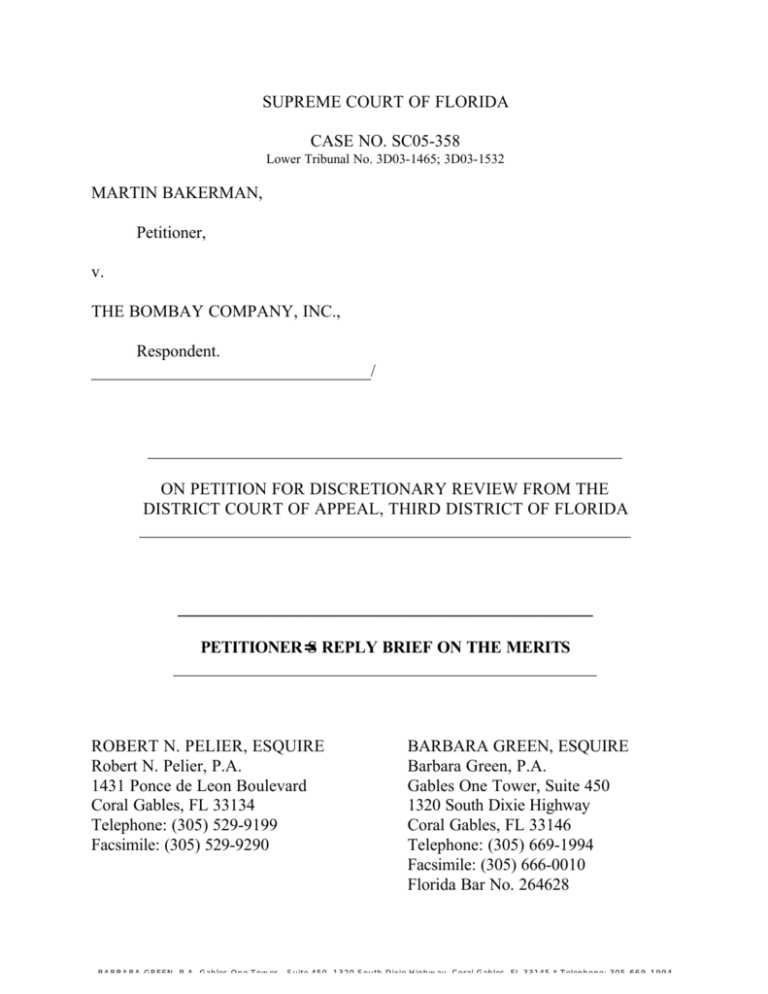
SUPREME COURT OF FLORIDA CASE NO. SC05-358 Lower Tribunal No. 3D03-1465; 3D03-1532 MARTIN BAKERMAN, Petitioner, v. THE BOMBAY COMPANY, INC., Respondent. _________________________________/ ________________________________________________________ ON PETITION FOR DISCRETIONARY REVIEW FROM THE DISTRICT COURT OF APPEAL, THIRD DISTRICT OF FLORIDA __________________________________________________________ _________________________________________________ PETITIONER=S REPLY BRIEF ON THE MERITS __________________________________________________ ROBERT N. PELIER, ESQUIRE Robert N. Pelier, P.A. 1431 Ponce de Leon Boulevard Coral Gables, FL 33134 Telephone: (305) 529-9199 Facsimile: (305) 529-9290 BARBARA GREEN, ESQUIRE Barbara Green, P.A. Gables One Tower, Suite 450 1320 South Dixie Highway Coral Gables, FL 33146 Telephone: (305) 669-1994 Facsimile: (305) 666-0010 Florida Bar No. 264628 BARBARA GREEN, P.A. Gables One Tower - Suite 450, 1320 South Dixie Highway, Coral Gables, FL 33145 * Telephone: 305-669-1994 TABLE OF CONTENTS REPLY TO STATEMENT OF FACTS ............................................................... 1 ARGUMENT ..................................................................................................... 2 I. THE EVIDENCE WAS SUFFICIENT FOR THE JURY TO FIND AN INTENTIONAL TORT UNDER THE OBJECTIVE SUBSTANTIAL CERTAINTY TEST OF TURNER V. PCR, INC. 2 II. THE DECISION BELOW DOES EXPRESSLY AND DIRECTLY CONFLICT WITH THIS COURT=S DECISIONS IN TURNER AND TRAVELERS 11 III. REPLY TO AMICUS BRIEF 13 CONCLUSION ................................................................................................ 14 CERTIFICATE OF SERVICE .......................................................................... 15 CERTIFICATE OF COMPLIANCE .................................................................. 15 BARBARA GREEN, P.A. Gables One Tower - Suite 450, 1320 South Dixie Highway, Coral Gables, FL 33145 * Telephone: 305-669-1994 2 TABLE OF AUTHORITIES Aguilera v. Inservices, Inc., 905 So. 2d 84 (Fla. 2005) .................................................................................. 10 Arroyo v. Scottie=s Professional Window Cleaning, Inc., 120 N.C. App. 154, 461 S.E. 2d 13 (N.C. App. 1995) ........................................... 5 Bombay Co. v. Bakerman, 2004 WL 735628 (Fla. 3d DCA 2004), reversed on rehearing, 891 So. 2d 555 (Fla. 3d DCA 2004) .................................... 7 Connelly v. Arrow Air, Inc., 568 So. 2d 448 (Fla. 3d DCA 1990) ..................................................................... 7 Gerth v. Wilson, 774 So. 2d 5 (Fla. 2d DCA 2000) ...................................................................... 11 Ingram v. Pettit, 340 So. 2d 922 (Fla. 1976) .................................................................................. 3 Jacobellis v. State of Ohio, 378 U.S. 184, 84 S.Ct. 1676 (1964) ..................................................................... 4 Kielwein v. Gulf Nuclear, Inc., 783 S.W. 2d 746 (Tex. App. 1990) ...................................................................... 5 Lemay v. Kondrk, 860 So. 2d 1022 (Fla. 5th DCA 2003) ................................................................... 3 Lusk v. Monaco Motor Homes, Inc., 775 P.2d 891 (Ore. App. 1989) ........................................................................... 8 Major v. Fireman=s Fund, 506 So. 2d 583 (La. App. 1987) .......................................................................... 9 Merrill Crossings Assoc. v. McDonald, 705 So. 2d 560 (Fla. 1997) .................................................................................. 9 Nesbitt v. Auto-Owners Ins. Co., 390 So. 2d 1209 (Fla. 5th DCA 1980) ................................................................... 4 BARBARA GREEN, P.A. Gables One Tower - Suite 450, 1320 South Dixie Highway, Coral Gables, FL 33145 * Telephone: 305-669-1994 3 Pastva v. Naegele Outdoor Advertising, Inc., 121 N.C. App. 656, 468 S.E. 2d 142 (N.C. App. 1996) ......................................... 5 Perl v. K-Mart Corp., 576 So. 2d 412 (Fla. 3d DCA 1991) ..................................................................... 8 Robinson v. North American Salt Co., 865 So. 2d 98 (La. App. 2003) .......................................................................... 10 Spivey v. Battaglia, 258 So. 2d 815 (Fla. 1972) ........................................................................ 2,12,14 State v. Wise, 464 So. 2d 1245 (Fla. 1st DCA 1985) ................................................................... 4 Stump v. Industrial Steeplejack Co., 104 Ohio App. 3d 86, 661 N.E. 2d 212 (Ohio App. 1995) ...................................... 5 Travelers Indem. Co. v. PCR, Inc., 889 So. 2d 779 (Fla. 2004) ................................................................................ 11 Turner v. PCR, Inc, 754 So. 2d 683 (Fla. 2000) .................................................................................. 2 OTHER AUTHORITIES: '440.015, Florida Statutes ................................................................................. 13 '440.11, Florida Statutes (2003) ........................................................................ 14 6 Larson=s Worker=s Compensation Law '103.4[4] (2005) .................................5,14 Henke, Richard C., Workers= Compensation in New Jersey: Toward a Removal of Workers from the Sacrificial Altar of Production Quotas, 56 Rutgers L. Rev. 789 (2004) ........................................................................................................................ 10 REPLY TO STATEMENT OF FACTS BARBARA GREEN, P.A. Gables One Tower - Suite 450, 1320 South Dixie Highway, Coral Gables, FL 33145 * Telephone: 305-669-1994 4 Petitioner Bakerman stands by the statement of facts in his initial brief. The evidence at trial showed that, again and again, Mr. Bakerman complained to his store manager about the wobbly, rickety wooden ladder. The district manager visited the store several times a month. Each time, the store manager complained to him about the ladder and told him someone was going to get hurt. The district manager saw the ladder himself, and was well aware of its dangerous condition (T.122-23, 182-84). Yet Bombay refused to authorize the expenditure of money to buy a new ladder (T.122, 184). Eventually the inevitable happened. Mr. Bakerman happened to be the unfortunate employee who was at the top of the ladder when it fell. Bombay points out that Mr. Bakerman Apositioned the ladder against the vertical rails of the shelving without opening it@ (Answer Brief p. 2). The reason Mr. Bakerman had to do that is because, in that cramped, crowded store room, there was not enough room to open the ladder (T. 179). In order to perform his job, Mr. Bakerman had to retrieve merchandise from the top shelves in the store room. In order to get to that merchandise, he had to use that ladder. It was the only ladder Bombay gave him to use (T.121). It was wobbly. It was rickety. It swayed. It was too short for the task. It could not be fully opened in that space (T.178-81). Mr. Bakerman had no choice but to use that ladder because, in spite of repeated requests from Mr. Bakerman and his store manager, Bombay refused to get a new ladder BARBARA GREEN, P.A. Gables One Tower - Suite 450, 1320 South Dixie Highway, Coral Gables, FL 33145 * Telephone: 305-669-1994 2 (T.122-23, 182-84). Mr. Bakerman was afraid that, if he refused to climb the ladder to get the merchandise, he would be fired (T.187). Finally, the jury was specifically instructed on the substantial certainty standard, including an instruction that Amere probability@ was not enough (T.480). ARGUMENT I. THE EVIDENCE WAS SUFFICIENT FOR THE JURY TO FIND AN INTENTIONAL TORT UNDER THE OBJECTIVE SUBSTANTIAL CERTAINTY TEST OF TURNER V. PCR, INC. The evidence which the jury believed at trial was sufficient to prove that Bombay committed an intentional tort under the objective test adopted by this Court in Turner v. PCR, Inc, , 754 So.2d 683 (Fla. 2000): Awhere a reasonable man would believe that a particular result was substantially certain to follow, he will be held in the eyes of the law as though he had intended it.@ 754 So. 2d at 688, citing Spivey v. Battaglia, 258 So. 2d 815, 817 (Fla. 1972). Most of Bombay=s argument is taken up with the semantics of whether its conduct was Amore than gross negligence@ or Aworse than gross negligence.@ But calling something Amore@ or Aworse@ than gross negligence does not answer the question. Discerning the difference between negligence and intent requires more than repetition of words. A[T]he distinction between intent and negligence boils down to a matter of degree,@ Spivey, 258 So. 2d at 817. ANegligence and intentional misconduct describe points on a range of conduct that is potentially negligent; what lies between negligence and BARBARA GREEN, P.A. Gables One Tower - Suite 450, 1320 South Dixie Highway, Coral Gables, FL 33145 * Telephone: 305-669-1994 3 misconduct constitutes the degree of negligence.@ Lemay v. Kondrk, 860 So.2d 1022, 1025 (Fla. 5th DCA 2003) (Orfinger, J., dissenting). The degree of fault, whether mere negligence, some aggravated kind of negligence, or intent, is not determined by semantics. It is determined by public policy and the facts of the particular case.1 Ingram v. Pettit, 340 So.2d 922 (Fla. 1976). Our jurisprudence reflects a history of difficulty in dividing negligence into degrees. The distinctions articulated in labeling particular conduct as 'simple negligence', 'culpable negligence', 'gross negligence', and 'willful and wanton misconduct' are best viewed as statements of public policy. These semantic refinements also serve a useful purpose in advising jurors of the factors to be considered in those situations where the lines are indistinct. We would deceive ourselves, however, if we viewed these distinctions as finite legal categories and permitted the characterization alone to cloud the policies they were created to foster. Our guide is not to be found in the grammar, but rather in the policy of the state . . . . Ingram, 340 So.2d at 924. 1 Bombay=s comparisons of the facts of this case to cases which were decided before Turner and which did not apply Turner=s objective substantial certainty test are not helpful in determining whether the facts of this case satisfy the Turner test. BARBARA GREEN, P.A. Gables One Tower - Suite 450, 1320 South Dixie Highway, Coral Gables, FL 33145 * Telephone: 305-669-1994 4 Thus, in order to determine whether Bombay=s conduct was intentional under the objective substantial certainty test of Turner, we must look, not just to words, 2 but to policy, and to the specific facts presented to the jury. It is the policy of the state to hold tortfeasors responsible for their intentional torts. Turner, 754 So.2d at 689 (Athe worker=s compensation scheme is not intended to insulate employers from liability for intentional torts@); Nesbitt v. Auto-Owners Ins. Co., 390 So.2d 1209 (Fla. 5th DCA 1980). The policy of the state, determined by this Court in Turner, should discourage employers, who are repeatedly warned about serious dangers to employees, from refusing to take action to prevent the impending injury. The policy should encourage employers like Bombay to spend a few dollars to buy a new ladder when employees repeatedly request it because the existing ladder is defective and unsafe. It is also the policy of this state to have the question of intent determined by a jury. E.g., State v. Wise, 464 So.2d 1245 (Fla. 1st DCA 1985). The facts presented to the jury below were sufficient to support a finding of intent. Courts that have adopted the Asubstantial certainty@ test have found that the allegations or evidence were sufficient to go to a jury Aif the employer has been specifically warned of a dangerous situation prior to Bombay=s argument is reminiscent of the AI know it when I see it@ school of thought. Cf. Jacobellis v. State of Ohio, 378 U.S. 184, 84 S.Ct. 1676 (1964) (Stewart, J., concurring). But that kind of reasoning, though often quoted, has never been a useful standard to apply when deciding cases based on actual facts. 2 BARBARA GREEN, P.A. Gables One Tower - Suite 450, 1320 South Dixie Highway, Coral Gables, FL 33145 * Telephone: 305-669-1994 5 the event that caused the injury and failed to take corrective action, or ordered the employee to perform a task in an unsafe manner when safer alternatives were available.@ 6 Larson=s Worker=s Compensation Law '103.4[4] (2005) (footnotes omitted). Courts have found that the substantial certainty test was met where, as here, the employer had actual knowledge of the dangerous condition, knew that injury to its employee was substantially certain to occur, and nevertheless required the employee to continue to perform the dangerous task. See, e.g., Stump v. Industrial Steeplejack Co., 104 Ohio App. 3d 86, 661 N.E. 2d 212 (Ohio App. 1995); Kielwein v. Gulf Nuclear, Inc., 783 S.W. 2d 746 (Tex. App. 1990); Pastva v. Naegele Outdoor Advertising, Inc., 121 N.C. App. 656, 468 S.E. 2d 142 (N.C. App. 1996) ; Arroyo v. Scottie=s Professional Window Cleaning, Inc., 120 N.C. App. 154, 461 S.E. 2d 13 (N.C. App. 1995). For example, in Stump, the plaintiff, before beginning work on the outside of a building, saw that the scaffolding rope was discolored and rotted. He called it to the supervisor=s attention. The supervisor refused to delay the work to get another rope because it was too time-consuming. The rope broke, and the plaintiff fell from the scaffold and was injured. The court held that the question of whether the employer was guilty of an intentional tort was for the jury, because the supervisor had actual knowledge that the rope was rotten and nevertheless required the plaintiff to use it to support the scaffold. Similarly, in Kielwein, the plaintiff was ordered to clean up a room that had been contaminated with radioactive isotopes, and his employer refused his request for BARBARA GREEN, P.A. Gables One Tower - Suite 450, 1320 South Dixie Highway, Coral Gables, FL 33145 * Telephone: 305-669-1994 6 protective equipment. The court held that there was an issue of material fact as to whether the employer=s conduct rose to the level of an intentional tort. Likewise, in Pastva, the defendant had actual knowledge that the billboard on which it required the plaintiff to work was Aunsafe and dangerous immediately before it collapsed,@ and nevertheless ordered the plaintiff to work on the billboard. The court held that the complaint sufficiently alleged an intentional tort. And, in Santos, the defendant window cleaning company required the plaintiff to clean windows by standing on the roof and leaning over, without safety equipment, because the safer methods of washing the windows from the ground using a scaffold or ladders or a telescoping power washer were too time consuming. In order to speed up the work, the supervisor instructed two workers to work separately, rather than allowing one worker to hold onto the other. The plaintiff fell from the roof. The court held these allegations were sufficient allegations of an intentional tort to withstand a motion to dismiss. Moreover, contrary to Bombay=s argument, there is no requirement that the employer know of injuries prior to the plaintiff=s injuries before a jury may find an intentional tort under the substantial certainty test. While a jury may consider prior injuries as a factor in determining whether the plaintiff=s injury was substantially certain to occur, the jury may also consider, as the panel noted in its original opinion, whether the situation grew increasingly dangerous each time the defective equipment was used, until the inevitable finally happened. AThe jurors= common sense would tell them that repeated BARBARA GREEN, P.A. Gables One Tower - Suite 450, 1320 South Dixie Highway, Coral Gables, FL 33145 * Telephone: 305-669-1994 7 use of this wooden ladder would only grow worse with repeated use, thus increasing the danger.@ Bombay Co. v. Bakerman, 2004 WL 735628 (Fla. 3d DCA 2004), reversed on rehearing, 891 So. 2d 555 (Fla. 3d DCA 2004). See generally, e.g., Connelly v. Arrow Air, Inc., 568 So. 2d 448 (Fla. 3d DCA 1990). Here, Bombay knew of the exceedingly dangerous condition of the ladder. Mr. Bakerman and his supervisor repeatedly complained about the ladder to the district manager. The store manager repeatedly asked for authorization to buy a better ladder, warning the district manager that someone was going to get hurt. Bombay nevertheless continued to require Mr. Bakerman to use the ladder to retrieve merchandise from the store room, instead of simply spending a few dollars to buy a new ladder. Both Bombay and the Amicus have conflated the issue of Bombay=s fault with the issue of any fault attributable to Mr. Bakerman. They argue that, because Mr. Bakerman himself repeatedly warned Bombay of the dangerous condition of the ladder, Bombay should not be held liable in tort. But whether Mr. Bakerman was negligent or not has nothing to do with whether Bombay=s conduct was intentional or negligent under the objective test. Compare generally, Perl v. K-Mart Corp., 576 So.2d 412 (Fla. 3d DCA 1991) (customer=s negligence did not preclude directed verdict that premises owner was negligent). Either Bombay knew or should have known that its conduct was substantially certain to cause serious injury to Mr. Bakerman, or it didn=t. Whether Mr. Bakerman also knew has nothing to do with Bombay=s state of mind. BARBARA GREEN, P.A. Gables One Tower - Suite 450, 1320 South Dixie Highway, Coral Gables, FL 33145 * Telephone: 305-669-1994 8 The fact that the employee complained to the employer repeatedly about the dangerous condition should not absolve the employer of responsibility for failing to remedy it. Such warnings from the employee make the employer=s refusal to alleviate the danger B here, by simply buying a new ladder B more egregious, not less. Other courts have found evidence sufficient to support an intentional tort even when the employee was aware of the dangerous condition. In fact, in Stump, Kielwein and Arroyo, as in the present case, it was the plaintiff himself who called the dangerous condition to the employer=s attention. See also, e.g., Lusk v. Monaco Motor Homes, Inc., 775 P.2d 891 (Ore. App. 1989) (jury could find employer committed intentional tort in refusing plaintiff=s repeated requests for a respirator to protect him from fumes); Major v. Fireman=s Fund, 506 So.2d 583 (La. App. 1987) (reversing summary judgment where plaintiff repeatedly complained that his mask was not working and employer refused to provide a new one). Knowledge on the part of the plaintiff simply does not preclude intent on the part of the employer.3 Turner allows an employee to show intent either by showing subjective intent or by satisfying the objective substantial certainty test. The employee=s lack of knowledge of the danger may be relevant under a subjective test if the employer has deliberately concealed 3 The Amicus brief makes much of Mr. Bakerman=s failure to challenge the jury=s allocation of one third of the fault to him. Although it is erroneous to compare the fault of a negligent victim with that of an intentional tortfeasor, see Merrill Crossings Assoc. v. McDonald, 705 So.2d 560 (Fla. 1997), that issue could not be raised on appeal because it was not raised below. But the issue of whether Bombay=s conduct was intentional under the objective test was raised below, and is properly before this Court. BARBARA GREEN, P.A. Gables One Tower - Suite 450, 1320 South Dixie Highway, Coral Gables, FL 33145 * Telephone: 305-669-1994 9 the danger from the employee, because that concealment is evidence of the employer=s subjective intent. But the employee=s knowledge of the danger does not preclude a finding of the employer=s intent under the objective substantial certainty test. The jury was specifically instructed on the substantial certainty requirement, and that "mere probability" was not enough to find Bombay liable for an intentional tort (T.480). The jury's finding that Mr. Bakerman was negligent does not negate the jury's finding that Bombay committed an act that was substantially certain to cause injury to Mr. Bakerman. At least as relevant as the employee=s knowledge or lack of knowledge of the danger is the disparity of power between the employer and the employee. Courts often have noted that an employee, even though aware of the danger, may be afraid to refuse to do the work as instructed because of fear of losing his job. E.g., Stump, supra,; Arroyo, supra.; Robinson v. North American Salt Co., 865 So.2d 98 (La. App. 2003). Mr. Bakerman testified to exactly that fear: Well, you have a customer come to the store and they buy something, I don=t think I would have kept my job very long if I had said, well, I=m sorry I can=t give it to you, I have got a defective ladder. You make do with the tools the company gives you to do, period, and you do your job. (T.187). This is the ultimate power that employers have over employees. It is an abuse of an employer=s power to treat employees as if they were just equipment, to be used, discarded, and replaced when broken. See Henke, Richard C., Workers= Compensation in New Jersey: Toward a Removal of Workers from the Sacrificial Altar of Production BARBARA GREEN, P.A. Gables One Tower - Suite 450, 1320 South Dixie Highway, Coral Gables, FL 33145 * Telephone: 305-669-1994 10 Quotas, 56 Rutgers L. Rev. 789 (2004) (cited in Amicus Brief p. 12-13). See generally Aguilera v. Inservices, Inc., 905 So.2d 84 (Fla. 2005) (noting that injured employee was Aat the mercy of@ the worker=s compensation carrier). Allowing an intentional tort cause of action in circumstances like these is more than just an exercise in semantics. It is salutary public policy, which benefits both employees and employers, as well as the workers= compensation system itself. As one court observed: Beyond the obvious social value in protecting employees from intentional torts of employers, there is also an economic benefit to the workers= compensation system. The threat of an employer=s added liability, outside the protection of workers= compensation, would elevate an employer=s interest in providing for the safety of workers, thus lessening injuries in the work place. The significance of a reduction in injuries is, we believe, obvious. Gerth v. Wilson, 774 So.2d 5, 7 (Fla. 2d DCA 2000). Holding an employer responsible for its obstinate refusal to fix an extremely dangerous condition of which it had actual knowledge, based on repeated complaints from subordinates, including the employee who eventually was injured, can only help employees, employers, and the workers= compensation system to make the work place safer, reduce employee injuries, and reduce the cost to employers and to society as a whole. BARBARA GREEN, P.A. Gables One Tower - Suite 450, 1320 South Dixie Highway, Coral Gables, FL 33145 * Telephone: 305-669-1994 11 II. THE DECISION BELOW DOES EXPRESSLY AND DIRECTLY CONFLICT WITH THIS COURT=S DECISIONS IN TURNER AND TRAVELERS. This Court made clear in Turner and in Travelers Indem. Co. v. PCR, Inc., 889 So.2d 779 (Fla. 2004) that one test to determine whether an employer committed an intentional tort is the objective, substantial certainty test of Spivey v. Battaglia, 258 So.2d 815 (Fla. 1992): whether Aa reasonable man would believe that a result was substantially certain to follow . . . .@ That test does not require actual knowledge or subjective intent. Bombay argues that the Third District below did not impose a concealment requirement B and thus a subjective intent requirement B on the objective substantial certainty test. But the specific holding below was that the substantial certainty test was not satisfied because there was no evidence of concealment: Of particular interest here, the Turner decision also points out that the cases finding liability under the intentional tort exception contain Aa common thread of evidence that the employer tried to cover up the danger, affording the employees no means to make a reasonable decision as to their actions.@ 754 So.2d at 691 [internal citations omitted]. That element is missing here. Here, . . . the dangerous condition was evident to the employee and there was no concealment of the danger. For that reason we conclude that the evidence was legally insufficient to support liability under the intentional tort exception to worker=s compensation immunity. BARBARA GREEN, P.A. Gables One Tower - Suite 450, 1320 South Dixie Highway, Coral Gables, FL 33145 * Telephone: 305-669-1994 12 891 So.2d at 557 (emphasis added)(citation omitted). Bombay=s argument that the Third District did not impose a concealment requirement is simply wrong. The Acover up@ was the Aelement@ that the Third District found to be Amissing.@ It was Afor that reason@ that a finding of intent was precluded . A Acover up@ requires knowledge of the thing to be covered up, and a subjective intent to conceal it. Thus, the Third District did, in fact, convert this Court=s objective test into a subjective test. The decision below does expressly and directly conflict with Turner and Travelers. III. REPLY TO AMICUS BRIEF Much of what has been said so far in reply to Bombay=s brief is equally applicable to the Amicus brief. The Amicus brief is essentially a polemic arguing against the objective substantial certainty standard because it is not Apro business.@ That argument comes too late, because this Court already adopted the objective standard in Turner. The Amicus brief advocates a position that is frankly pro-business. See e.g. Amicus Brief p. 3-4 (Interest of Amicus); Id. p. 18 (advocating Apro-business sentiment@). This is a fine position for the Pacific Legal Foundation to take, but it is not the position that the Florida Legislature has taken. The Legislature expressly has prohibited construing the statute in favor of either the employer or the employee. '440.015, Florida Statutes; Turner, 754 So.2d at 689. The Amicus argues that a decision by this Court upholding the jury=s verdict will trigger Arepercussions@ and Apitfalls@ and running battles between the courts and the legislature. No such Arepercussions@ will result from the Court=s decision in this case. BARBARA GREEN, P.A. Gables One Tower - Suite 450, 1320 South Dixie Highway, Coral Gables, FL 33145 * Telephone: 305-669-1994 13 First, the leading treatise has observed, in those jurisdictions adopting the substantial certainty test, Athe predicted flood of litigation has not occurred.@ 6 Larson=s Workers= Compensation Law '103.4[4] (2005). Therefore, it is difficult to understand what Arepercussions@ could result from this Court=s clarification of a standard it already adopted. Moreover, the Legislature has amended the worker=s compensation statute to create an intentional tort exception for future cases, with specific requirements. See '440.11, Florida Statutes (2003). That statute is not applicable here, and Mr. Bakerman does not challenge it or even ask this Court to construe it. All Mr. Bakerman asks this Court to do is to clarify the law applicable to the many cases that arose before the amendment, including his case against Bombay, and, in the process, to clarify what constitutes an intentional tort under the Aobjective@ test which has long been a part of Florida law, and which is also applicable in other contexts. See, e.g., Spivey v. Battaglia, 258 So.2d 815 (Fla. 1972). Mr. Bakerman asks the Court simply to clarify the objective substantial certainty test. CONCLUSION Petitioner Bakerman respectfully asks this Court to reverse the decision of the Third District and to reinstate the jury=s verdict. CERTIFICATE OF SERVICE BARBARA GREEN, P.A. Gables One Tower - Suite 450, 1320 South Dixie Highway, Coral Gables, FL 33145 * Telephone: 305-669-1994 14 I HEREBY CERTIFY that a true and correct copy of the foregoing was furnished via U.S. Mail to: ROBERT E. BIASOTTI, ESQUIRE and ANNETTE LANG, ESQUIRE, Carlton Fields, P.A., P.O. Box 2861, St. Petersburg, FL 33731; and ROBERT SCOTT NEWMAN, ESQUIRE, Marlow, Connell, Valerius, et al., 4000 Ponce de Leon Boulevard, Suite 570, Coral Gables, FL 33146 this ______ day of November, 2005. Respectfully submitted, BARBARA GREEN, P.A. Gables One Tower, Suite 450 1320 South Dixie Highway Coral Gables, FL 33146 Telephone: (305) 669-1994 Facsimile: (305) 666-0010 ROBERT N. PELIER, ESQUIRE Robert N. Pelier, P.A. 1431 Ponce de Leon Boulevard Coral Gables, FL 33134 Telephone: (305) 529-9199 Facsimile: (305) 529-9290 BY:___________________________ BARBARA GREEN, ESQUIRE Florida Bar No. 264628 CERTIFICATE OF COMPLIANCE I HEREBY CERTIFY that the foregoing brief has been computer generated in 14 point Times New Roman and complies with the requirements of Rule 9.210. _______________________________ BARBARA GREEN Florida Bar No. 264628 BARBARA GREEN, P.A. Gables One Tower - Suite 450, 1320 South Dixie Highway, Coral Gables, FL 33145 * Telephone: 305-669-1994 15

